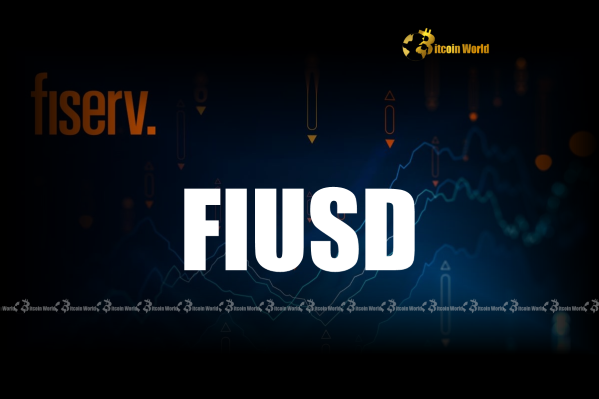BitcoinWorld

Fiserv Unleashes Enterprise FIUSD Stablecoin on Solana
The world of finance is constantly evolving, and the lines between traditional systems and decentralized technologies are blurring faster than ever. A significant move signaling this shift comes from a major player in the payments industry. Get ready to learn about a development that could reshape how businesses handle transactions: the upcoming launch of the Fiserv FIUSD stablecoin.
What is the Fiserv FIUSD Stablecoin and Why Does it Matter?
Fiserv, a company that sits comfortably within the Fortune 500 and is a cornerstone of the global payments infrastructure, has announced ambitious plans to enter the stablecoin market. The company intends to launch its own fiat-backed digital currency, dubbed FIUSD stablecoin, before the end of the year. This isn’t just another crypto project; it’s a move by a titan of traditional finance, aiming to integrate blockchain technology directly into the systems that power countless banks and merchants worldwide.
The significance lies in Fiserv‘s scale and reach. They provide payment processing services, banking core systems, and various financial technologies to thousands of institutions. Introducing a payments stablecoin directly into this ecosystem has the potential for widespread impact, bringing the benefits of digital currency to a massive, established user base.
The FIUSD stablecoin is described as ‘programmable money.’ This term highlights one of the core advantages of digital currencies built on blockchain: the ability to embed logic directly into the money itself. This could enable automated payments, conditional transfers, instant settlements, and other complex financial operations that are cumbersome or impossible with traditional systems.
Why Solana? The Choice of Blockchain for the Fiserv Stablecoin
A crucial piece of the puzzle is Fiserv‘s choice of blockchain: Solana. Known for its high throughput, low transaction costs, and fast finality, Solana has emerged as a strong contender for enterprise-level applications requiring speed and efficiency. For a payments stablecoin designed for potentially high-volume transactions within a large financial network, these characteristics are paramount.
Choosing Solana for the Fiserv stablecoin suggests a strategic decision based on performance requirements. Unlike some earlier blockchains, Solana is built to handle a massive number of transactions per second, which is essential for scaling a payment solution across Fiserv’s extensive network of clients and merchants. The lower fees associated with Solana transactions compared to, say, Ethereum, also make it more viable for frequent, smaller payments.
This choice also represents a significant endorsement for the Solana ecosystem, bringing a major enterprise player onto the network. It could potentially drive further development and adoption of enterprise-grade tools and infrastructure on Solana.
Leveraging Industry Leaders: Paxos and Circle Infrastructure
To build and launch the FIUSD stablecoin, Fiserv is not starting from scratch. The plan involves leveraging the infrastructure provided by two established players in the stablecoin and digital asset space: Paxos and Circle. This is a smart move that provides several advantages:
- Regulatory Expertise: Both Paxos and Circle have significant experience navigating the complex regulatory landscape surrounding stablecoins and digital assets in the U.S.
- Proven Technology: They provide robust technology for stablecoin issuance, management, and redemption, which can accelerate Fiserv’s time to market and ensure reliability.
- Trust and Compliance: Partnering with well-known entities like Paxos and Circle adds a layer of credibility and helps ensure the FIUSD stablecoin is built on a foundation of compliance and security.
This collaboration highlights a trend where traditional finance leverages the expertise and existing infrastructure of native crypto companies to enter the digital asset space, rather than building everything in-house.
Boosting Efficiency: The Core Benefit of the Fiserv Stablecoin
The primary stated goal for the FIUSD stablecoin is to enhance efficiency for Fiserv‘s financial institution clients and the merchants they serve. How exactly can a stablecoin achieve this? Here are some key areas where efficiency gains are expected:
- Faster Settlements: Traditional payment systems often involve intermediaries and batch processing, leading to delays of days for funds to settle. A stablecoin on a fast blockchain like Solana can enable near-instantaneous settlement, freeing up capital and improving cash flow for businesses.
- Reduced Costs: By potentially cutting out intermediaries and streamlining processes, transaction costs could be reduced, especially for cross-border payments.
- Improved Reconciliation: Programmable money allows for richer data to be embedded with transactions, simplifying the reconciliation process for businesses.
- 24/7 Availability: Unlike traditional banking hours, blockchain networks operate around the clock, enabling payments and settlements at any time.
- New Business Models: The ‘programmable’ nature of the FIUSD stablecoin could unlock entirely new ways for businesses to interact financially, such as automated supply chain payments triggered by events, or instant rebates and loyalty programs.
This focus on practical, tangible benefits like efficiency and cost reduction is crucial for driving enterprise adoption of blockchain technology.
Market Context: U.S. Stablecoin Legislation on the Horizon
The timing of Fiserv‘s announcement is notable, coinciding with increasing momentum towards federal stablecoin legislation in the United States. Lawmakers have been actively discussing and drafting frameworks to regulate stablecoins, aiming to provide clarity and consumer protection.
This legislative progress is likely a significant factor enabling large, regulated financial institutions like Fiserv to feel more comfortable entering the stablecoin market. A clear regulatory framework can reduce uncertainty, define operational requirements, and potentially pave the way for broader institutional adoption of stablecoins as a legitimate form of digital money within the existing financial system.
The development of an Enterprise stablecoin like FIUSD stablecoin aligns well with the goals of regulators seeking to integrate digital assets safely into the financial ecosystem, potentially offering a compliant pathway for widespread use.
Challenges and Considerations for the Fiserv Stablecoin
While the potential benefits are significant, launching an enterprise stablecoin is not without its challenges:
- Regulatory Nuances: Even with progress, the specific rules governing stablecoins are still evolving and may impact the operational requirements for FIUSD stablecoin.
- Integration Complexity: Integrating a new blockchain-based payment rail into complex legacy banking and merchant systems is a massive technical undertaking.
- Adoption Hurdles: Convincing financial institutions and merchants, many of whom are risk-averse, to adopt a new payment method requires significant effort in education, support, and demonstrating clear value.
- Competition: The stablecoin market is already competitive, with established players and other potential entrants from both the crypto native and traditional finance worlds.
- Technological Risks: While Solana is fast, like any blockchain, it carries potential risks related to network stability, security vulnerabilities, and evolving technology standards.
Successfully navigating these challenges will be key to the widespread adoption and impact of the FIUSD stablecoin.
Actionable Insights: What Does This Mean for Different Players?
The launch of the Fiserv FIUSD stablecoin has implications for various stakeholders:
- Financial Institutions & Merchants: Prepare for potential opportunities to leverage faster, cheaper, and more programmable payments. Understand the technology and how it can integrate with existing systems.
- Solana Ecosystem: This is a major validation. Developers and projects on Solana might see increased demand for tools and services compatible with enterprise use cases.
- Stablecoin Market: Increased competition and potential fragmentation, but also potential for overall market growth as a major traditional player enters.
- Other Enterprise Blockchains: Highlights the race to attract large financial clients and the importance of performance and regulatory compliance.
- Regulators: Provides a real-world example of a regulated entity attempting to integrate stablecoins, offering insights for future policy-making.
The Future of Payments: Will Stablecoins Like FIUSD Lead the Way?
The announcement from Fiserv is more than just news about a new digital asset; it’s a strong indicator of where the payments industry is heading. As traditional financial infrastructure meets blockchain innovation, we are likely to see a transformation in how money moves globally. The FIUSD stablecoin on Solana could be an early, significant step in this journey, paving the way for more efficient, programmable, and potentially more inclusive financial systems.
While the full impact remains to be seen, the commitment from a company like Fiserv to launch an enterprise stablecoin underscores the growing recognition of digital assets’ potential to solve real-world problems in finance.
Summary: A New Era for Enterprise Payments on Solana
In summary, Fiserv‘s plan to launch the FIUSD stablecoin on Solana by year-end, using Paxos and Circle infrastructure, is a landmark development. This enterprise stablecoin aims to bring the benefits of programmable money – speed, efficiency, and innovation – to Fiserv‘s vast network of financial institutions and merchants. Set against the backdrop of evolving U.S. stablecoin regulation, this move positions Fiserv at the forefront of integrating digital assets into mainstream finance and provides a significant boost to the Solana stablecoin ecosystem. The journey ahead involves navigating technical and adoption challenges, but the potential to revolutionize payments is clear.
To learn more about the latest enterprise stablecoin trends, explore our article on key developments shaping payments stablecoin institutional adoption.
This post Fiserv Unleashes Enterprise FIUSD Stablecoin on Solana first appeared on BitcoinWorld and is written by Editorial Team





